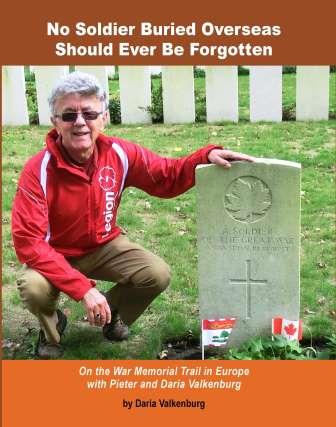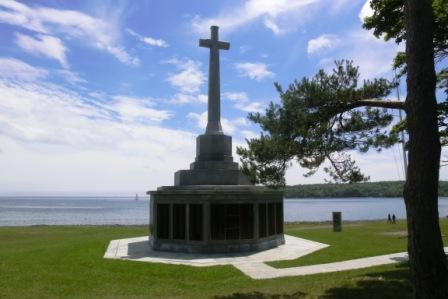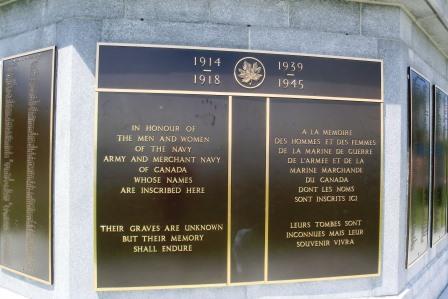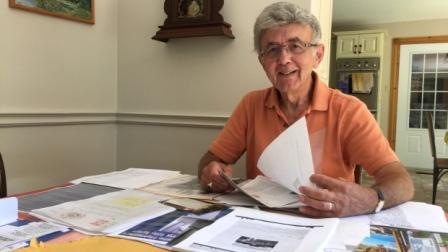October 25, 2018. Every November, volunteers from the Borden-Carleton Legion place Canadian flags at the graves of veterans in its service area. This is a large undertaking, as veterans are buried at 9 cemeteries. Most of the veterans in the cemeteries were survivors of wars and long after their period of active service.
While most of the names listed on the Cenotaph outside the Borden-Carleton Legion died while on active service overseas, there are a few listed who died in Canada in accidents or from illness, while on active service during WWI or WWII.
Pieter wondered why one veteran, who died while on active service during WWI and is buried at the Free Church of Scotland Cemetery in Cape Traverse, wasn’t listed on the Cenotaph. Was he missed? He visited the cemetery to see the grave. It was indeed a Commonwealth Grave, showing that Elmyr KRUGER had died October 21, 1918.

Grave of Elmyr Kruger at the Free Church of Scotland Cemetery in Cape Traverse. (Photo credit: Pieter Valkenburg)
He tried to find family on the island. No one knew who Kruger was. He found a radio interview with Dr. Helen Herring, in which she recalled stories of “German prisoners of war who died of influenza being secretly buried at night in the cemetery.” This wasn’t the first time Pieter had heard stories of German POWs buried on the island, but there was no proof.
While Kruger was a German name, and it was a puzzle why he was buried in a cemetery with mostly Scottish names, he had clearly been a Canadian soldier. Pieter decided to investigate further. From a search of the Canadian Virtual War Memorial, run by Veterans Canada, he very quickly he learned that Kruger was from the prairies, the son of Frank and Margaret Kruger of Millingar, North Battleford, Saskatchewan.
From his service file and research at Library and Archives Canada, Pieter discovered that Kruger’s story was tied to the story of German POWs on the island, and a shameful episode in the way that WW1 soldiers were treated by the local managers of the Canadian Government Railways.
Kruger’s father Frank, who was born in Prussia, immigrated to the USA at age 2 with his family. After 21 years in the USA, the family moved to Manitoba in 1891. His mother Margaret, nee Forsyth, was born in Manitoba, and had Scottish heritage. Elmyr was born November 1, 1896 in the farming community of Melita, Manitoba, the oldest of 5 children. Later the family moved to Millingar, Saskatchewan to farm there.
When he enlisted on May 28, 1916 it would have been a hardship to his family, as he would have been the only son old enough to help on the farm. Upon enlistment he was assigned to the newly formed 232nd (Saskatchewan) Overseas Battalion of the Canadian Expeditionary Force, where he unfortunately contracted measles and was hospitalized in North Battleford for two weeks, the Battalion’s base.
The 232nd Battalion was disbanded in the spring of 1917. On July 21, 1918 Kruger was transferred to the 6th Battalion Canadian Garrison Regiment from the 12th Battalion Canadian Garrison Regiment for escort duty.
There was a German prisoner of war camp in Amherst, Nova Scotia. In 1918, an agreement was made to bring German prisoners to work on the Borden branch of the Prince Edward Island Railway. The July 6, 1918 Guardian newspaper noted that 60 prisoners, accompanied by guards and officers, would be coming to the Island for the purpose of “doing such labour as ditching, putting in new ties, ballasting and putting the road in shape for the new rails to be laid in September. Eleven box cars are now being fitted up at the railway yard in Charlottetown for housing and otherwise accommodating the prisoners. These include two dining cars, five sleeping cars, two officers’ cars, one car for cooking and another.”
On August 5, 1918, the Guardian reported that 50 German prisoners, guarded by 27 men, arrived on the Island. On August 17, 1918, the Guardian explained that the prisoners were mostly “soldiers from the big liner Kaiser Wilhelm der Grosse”, with “several first class engineers among the number”. The liner was captured by the British off the coast of Africa in August 1914, and most of the crew ended up in Amherst Internment Camp.
According to the doctor’s report, Kruger became ill on October 11, 1918. A report to the Commanding Officer of the Amherst Internment Camp, filed by Lt R. Dunbar-Abbott, the officer in charge of the prisoner of war camp in Port Borden, who himself had been ill, outlines the frustrating events that may have contributed to the illness and subsequent deaths of three men. “While I was ill in hospital, a bad smell was noticed in the sleeping cars of the men. Sgt Major Lucas had the floor boards taken up and found about 6 inches of manure underneath (human, horse, cow, and sheep). The attention of Dr. J. McNeill was called to it and he remarked that it was not fit for cattle to live in. Many of the cars leaked. This was reported on September 27 and on several occasions after but nothing was done until November 7. With the exception of the cook cars nothing was done to the other cars.”
The reporting of the stinking cars was done to a Mr. Grady of the Railway. He doesn’t come off well in the report, as the report is filled with Grady’s complaints about the cost of food for those working on the railway, and his refusal to help when men started to fall ill. “Referring to the treatment on the outbreak of influenza, on October 12th I wired your instructions to Mr. Grady that proper accommodation should be provided for the sick. Nothing was done until the 15th when an extra box car was sent to us, ostensibly to be used as a cook car but no stove was sent until late on the night of the 16th. In the meantime food had to cooked in a farm house and carried to the car by Mrs. Abbott, who helped me out.”
In addition to his wife delivering food, Lt. Dunbar-Abbott received help from the Roman Catholic church. “We were visited by the Rev. Father McIntyre, who, seeing the appalling state of affairs, obtained the sanction of his Bishop to use their Mission Hall at Borden as a hospital where 10 military patients and civilian cook MacDonald were moved in on the night of October 17th. Next day three Railway employees were moved in, three of our men dying a few days later of pneumonia.”
“Repeated applications were made to Mr. Grady to provide a cook without any result.” The report goes on to say that “farmers refused milk, and the stores supplies if they were on Mr. Grady’s account. I only procured them on my own personal account, in case Mr. Grady refused to pay.” He noted that that he received no reply from Grady to his request for a cook or food supplies for the sick.
On October 17, two orderlies arrived. A nursing sister plus hospital equipment came the following day to help at the temporary hospital. “Later, a night nurse was sent for as the work was more than Mrs Abbott and Sister Fitzgerald could handle, the cases being so serious, and no cook.”
Help came too late for Kruger, who died in Port Borden (now Borden-Carleton) at 8 pm on October 21, 1918 of pneumonia after contracting Spanish flu. He was one of three guards who died.
On October 25, 1918 Sgt-Major Lucas reported on Kruger’s burial. “Acting on instructions from Lt. R. Dunbar-Abbott, I took the remains from Port Borden to the cemetery at Cape Traverse where he was buried. I had a firing party of 6 men and 4 pallbearers.”
According to the October 29, 1918 Guardian newspaper, two military funerals were held that day. In addition to Pte Kruger, Pte John Richard, who died October 20, 1918 of pneumonia following Spanish flu, had his funeral at the same time as Pte Kruger. The paper explained that “the deceased soldiers were returned men acting as guards at the Internment camp here. A firing party consisting of 15 men marched behind the remains of their dead comrades”, after which the body of Richard went on to Amherst, while services for Kruger’s burial in Cape Traverse “were conducted by the Rev. James McDougald.” On October 31, 1918 a Court of Inquiry was held into Kruger’s death and concluded that he “died from natural causes and that no blame is attachable to anybody”. No mention was made of the appalling and unsanitary conditions that the soldiers were subjected to.
There are no records of German prisoners of war being buried on Prince Edward Island. Pte Elmyr Kruger, who was sent from Saskatchewan as one of the guards, is only one of the three guards buried on the island. Pte Richard was buried in Sackville, New Brunswick. The third guard, Acting Corporal D. McKee, died on October 26, 1918. His body was sent to Fargo, North Dakota for burial. We don’t know why Kruger’s body was not sent to Saskatchewan for burial, nor has Pieter been able to find a photo of Kruger. But he’s no longer a forgotten soldier.
If you can add to this story, have photos or information to share on soldiers from the Cenotaph outside the Borden-Carleton Legion, or soldiers buried in The Netherlands, please let us know. You can share them by sending an email to memorialtrail@gmail.com or by commenting on this blog.
UPCOMING PRESENTATION: Pieter will speak about the Cenotaph Research Project at South Shore United Church in Tryon, 7 pm on Friday, November 2, 2018. This event is co-hosted by South Shore United Church and Tryon & Area Historical Society. Note: this venue is equipped with a hearing loop for the benefit of those with hearing loss. You are invited to bring photos and information on the men listed on the Cenotaph, or on any Canadian soldier buried in The Netherlands. Email memorialtrail@gmail.com for more info.
UPCOMING PRESENTATION: Pieter has been invited to be a guest speaker at St John The Evangelist Church in Crapaud during their Remembrance Day service, which begins at 10:30 am on Sunday, November 11, 2018.
© Daria Valkenburg
….Want to follow our research?….
If you are reading this posting, but aren’t following our research, you are welcome to do so. Our blog address: https://onthewarmemorialtrail.com/
 4 countries, 6 weeks, 7,000 km – an unforgettable war memorial journey in Europe…. Daria’s book ‘No Soldier Buried Overseas Should Ever Be Forgotten‘ is available in print and e-book formats. Net proceeds of book sales help support research costs and the cost of maintaining this blog. For more information see https://nosoldierforgotten.com/
4 countries, 6 weeks, 7,000 km – an unforgettable war memorial journey in Europe…. Daria’s book ‘No Soldier Buried Overseas Should Ever Be Forgotten‘ is available in print and e-book formats. Net proceeds of book sales help support research costs and the cost of maintaining this blog. For more information see https://nosoldierforgotten.com/
You are also invited to subscribe to our YouTube Channel: On The War Memorial Trail With Pieter Valkenburg: https://www.youtube.com/channel/UCJ591TyjSheOR-Cb_Gs_5Kw.
Never miss a posting! Subscribe below to have each new story from the war memorial trail delivered to your inbox.

 4 countries, 6 weeks, 7,000 km – an unforgettable war memorial journey in Europe…. Daria’s book ‘No Soldier Buried Overseas Should Ever Be Forgotten‘ is available in print and e-book formats. Net proceeds of book sales help support research costs and the cost of maintaining this blog. For more information see https://nosoldierforgotten.com/
4 countries, 6 weeks, 7,000 km – an unforgettable war memorial journey in Europe…. Daria’s book ‘No Soldier Buried Overseas Should Ever Be Forgotten‘ is available in print and e-book formats. Net proceeds of book sales help support research costs and the cost of maintaining this blog. For more information see https://nosoldierforgotten.com/ 



